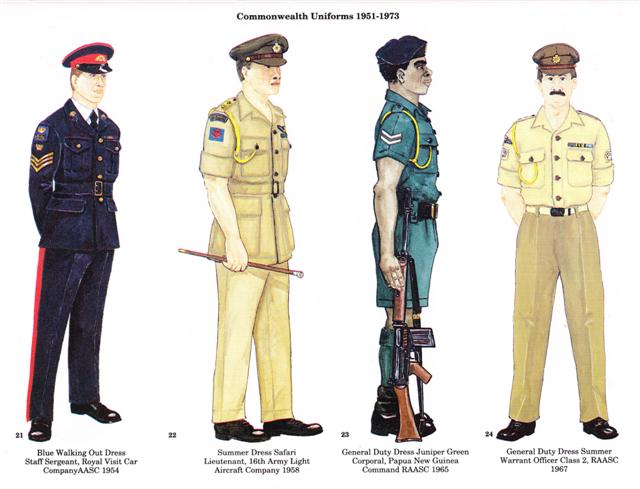AASC Commonwealth Uniforms 1940-1950

17. Field Dress Khaki Drill, Driver, 6th Division Australian Army Service Corps, 1941
It is hard to depict an Australian soldier in the Western Desert to show the full uniform without overdressing him on what was usually tolerated, but this applies to most working uniforms out of barracks. The shirt and trousers are standard tropical issue without the excesses of the bombay bloomers which appeared from time to time. Boots remained tan, a popular way of identifying Australians units on secret moves, and the leg wear shown, rather than the 1937 pattern, is cloth anklets secured by three buttons which was standard home service issue replacing puttees and taken by units to the Middle East. The steel helmet was widely preferred to the slouch hat in an environment of artillery and aircraft fire.
18. Field Dress Jungle Green, Sergeant, 7th Division Australian Army Service Corps, 1943
This depiction is based on a photo of an NCO taking out and escorting a carrier line to deliver forward to units in the Ramu Valley. The uniform is the simple jungle greens, 1937 basic webbing and Owen sub-machine carbine. American gaiters are shown, though these became increasingly rare as the US forces and trading opportunities moved on; while in 1943 most Australians seemed to have US ones, by 1945 they were back to ineffective 1937 anklets. Many also wore the slouch hat in the field without puggaree, some dandies still retained it, as did the model.
19. Service Dress Ceremonial, Private, British Commonwealth Occupation Force
Australian Army Service Corps, 1947
The long lived Service Dress remained as basic working and dress uniform, gaining ceremonial status by being cleaned and the addition of whitened basic webbing and anklets, and medals. Corps embellishments remained in abeyance until 1952, and anyway the force remained on active duty, wearing oxidised rising sun hat and collar badges and universal buttons. The short muzzle Lee Enfield rifle remained until the end of the next decade.
20. General Duty Battledress, Lance Corporal, Western Command Royal Australian
Army Service Corps, 1953
Following the British move of 1940, battledress came to the Australian Army a decade later, displacing the Service Dress as all purpose uniform, but with a blue dress uniform as an accompaniment. Corps badges were reintroduced in 1952, worn on the hat but not on the lapels of battledress. Original battledress were of a fine weave and slightly greenish tinge shown here; later deliveries were of a distinctly darker brown, coarser and with colour differences between jacket and trouser. The uniform could be worn with or without blancoed belt and anklets, later with black belt and gaiters, and slouch hat or blue beret.

21. Blue Walking Out Dress, Staff Sergeant, Royal Visit Car Company Royal Australian Army Service Corps, 1954
Blue uniforms were reintroduced in 1951 as walking out, ceremonial and mess dress after a war and postwar period of service dress and drill uniforms filling all purposes. An open neck jacket was selected after an opinion poll which opted for that after the discomfort of closed service dress collars, though this was illusory as a starched white shirt and black woollen tie were equally a problem in hot weather. The uniform shown is the basic one with cloth belt. Although corps badges had been reintroduced, the subject is shown with gilt rising sun hat and collar badges as the Car Company contained some other arms drivers, and the Australian Military Forces badges and buttons were selected for uniformity. Addition of a unit patch on the sleeve was abnormal, formation signs not being worn with blues. The uniform was raised to ceremonial level by addition of a whitened 1937 pattern belt or sword belt, and medals rather than ribbons.
22. General Duty Dress Safari, Lieutenant, 16 Light Aircraft Company, 1958
Summer dress of starched khaki drill shirt and trousers could be varied and upgraded a little for officers and warrant officers by replacing the shirt with a starched airtex khaki safari jacket, cloth belt and oxidised buckle. The normal sleeve insignia of corps title and formation sign, here Eastern Command, and the gold lanyard introduced in 1952 are included.
23. General Duty Dress Juniper Green, Corporal Papua New Guinea Command Royal Australian Army Service Corps, 1965
Until the formation of a separate command in Papua New Guinea the RAASC members wore jungle green uniforms. When PNG soldiers were transferred to RAASC, both Australian and PNG members wore the juniper green uniform, but not such accoutrements as the shoulder boards and black leather belt peculiar to Pacific Islands Regiment. A more casual footwear in the form of black leather sandals was used for everyday use, the black boots, puttees and green socks being used for parades. Blue beret with gilt RAASC badge rather than the PIR juniper green one, and gold lanyard completed the turnout; the self loading rifle had been in service for five years.
24. General Duty Dress Summer, Warrant Officer Class 2, Royal Australian Army Service Corps, 1967
Polyester shirt and polyester-wool khaki trousers replaced khaki drill and jungle greens as general and walking out dress in 1964, some years after Department of Supply had adopted similar clothes as working dress for its labourers. It was virtually without embellishment as the Military Board had made a meritorious decision in 1959 to strip the ever-increasing array of titles, signs, insignia, badges, and other assorted paraphernalia from uniforms, holding that rank, lanyard, corps badges and medal ribbons were ample. The main exception was for parachutist badges, which AASC air dispatch members often had, and later the air dispatch brevet and the long-discarded corps shoulder titles, were introduced. Headgear could include blue beret or slouch hat, and it could be worn with a knitted khaki tie. It was upgraded to ceremonial use by addition of a black web belt or sam browne and medals, with trousers loose or tucked into combat boots.